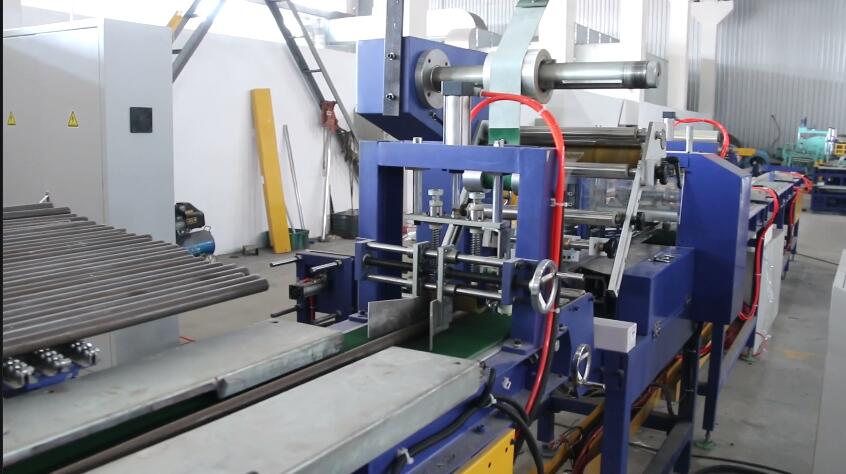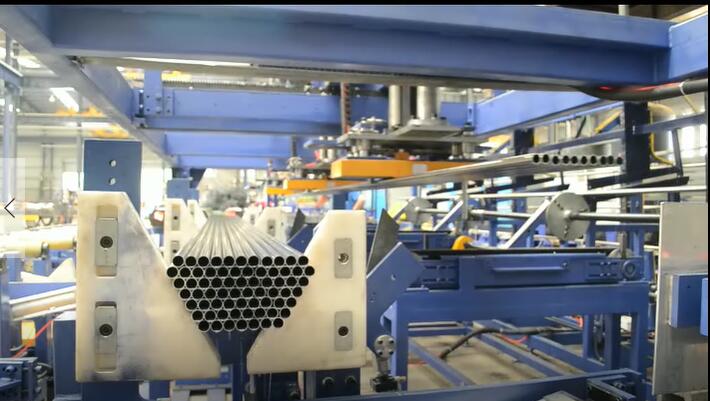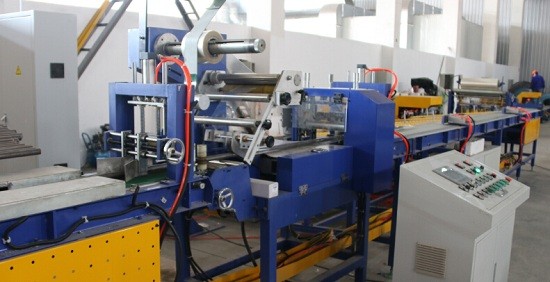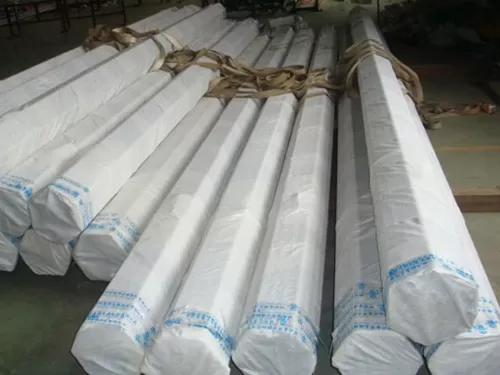What Makes an Automatic Steel Tube Bag Packing Machine Essential for Streamlined Operations?
I have witnessed how slow, manual packaging can disrupt workflows. Employees strain to keep up with orders, and inconsistent bagging leads to wasted time, damaged tubes, and expensive shipping errors.
An automatic steel tube bag packing machine solves these recurring problems. It streamlines wrapping tasks with proper tension, consistent seals, and fewer manual steps. It also protects each tube from external harm. Clients see fewer damaged shipments, while operators experience easier processes.
I believe this solution benefits many production lines. I want to show how automated bagging technology reduces labor strains, enhances quality, and supports flexible setups. This approach leads to a more efficient environment that handles big workloads without sacrificing consistency.
How Does Automated Bagging Elevate Efficiency and Product Protection?
I see many factories struggle with half-wrapped tubes or sloppy seals. That often causes shipping damage or contamination from dust or moisture.
An automated bagging machine fixes these issues by sealing steel tubes with uniform coverage and tension. It removes guesswork from staff, ensures the correct bag length, and prevents loose edges.
I find that precise automation also handles repetitive cycles without fatigue. That keeps pace high and product quality stable. Lines avoid rework, enjoy shorter packing times, and satisfy customers more reliably.
Maximizing Reliability and Preserving Steel Tubes

Consistent Bag Application
Steel tubes require adequate coverage to shield them from dirt or moisture. Automated machines detect tube length or diameter using sensors or preset measurements. They pull a bag film to the correct size, seal the open end, and cut the film precisely. This eliminates the frustration of guesswork or measuring tape. When every tube receives full coverage, the rate of damaged goods drops significantly.
Preventing Edge Damage
I often see small dents or sharp edges form when employees struggle with manual bagging. The bag might catch on the tube’s surface, causing a tear or friction. Automated systems guide the bag along a controlled path. They keep tension at a safe level to avoid stressing the tube’s surface. This approach removes the bumps and slippage common in manual wrapping, so edges stay intact.
Streamlined Throughput
High-volume orders can overwhelm staff who must manually load and seal bags. When a machine handles the entire wrapping cycle, the line moves quickly. Operators simply load tubes into a conveyor or staging area. The machine wraps them in sequence. That speed leads to fewer process breaks. It also frees staff to focus on final inspections or specialized tasks.
Protecting Surfaces and Finishes
Steel tubes often have coatings or finishes that rust easily if exposed to moisture. An automated bag keeps a controlled environment around the tube. It guards against ambient humidity or dust. This is especially important for shipments traveling long distances. Any scratch or rust on arrival diminishes client trust. When a packaging line produces consistent, sealed bags, the chance of oxidation drops.
| Benefit | How Automation Achieves It | Outcome |
|---|---|---|
| Correct Bag Sizing | Sensors measure each tube before sealing | Full coverage, no exposed sections |
| Even Tension Application | Machine sets uniform pressure on tubes | Prevents film tears or rough friction |
| Faster Cycle Times | Repetitive tasks handled by machine | Reduced labor hours, higher throughput |
| Enhanced Protection | Film encloses tube to shield from outside elements | Less corrosion, fewer returns |
| Consistent Sealing | Automated heat or mechanical seals | No leaking edges or partial closures |
Employee Safety and Comfort
Manual bagging can lead to repetitive strain. Workers hold heavy steel tubes at odd angles to load them into flimsy bags. Over time, that leads to sore joints and lost hours. An automated line uses conveyors or mechanical arms to position tubes. The operator rarely lifts or tilts them. Employees spend time monitoring the process instead, which saves them from repetitive injuries.
Lower Film Waste
I recall how employees sometimes cut big sections of bag film to make sure the tube is wrapped. That leads to leftover scraps. The scraps pile up, which wastes money. An automated machine calculates the required length precisely. The film spool unwinds only what is necessary. Over large production runs, that reduction in film usage saves considerable costs. It also keeps the shop floor clean.
Maintaining a Professional Finish
An automated bagging line produces uniform, neatly sealed tubes. That consistent appearance impresses customers. It shows that the business invests in quality packaging, which supports the brand’s reputation. It also builds trust among distributors, who see fewer complaints about damaged or unwrapped items. Automated bagging also allows easy labeling or barcoding if needed. Each tube can include a scannable code that identifies size or batch.
I think these factors display how a single piece of equipment enhances efficiency and product protection. By cutting out manual errors, the system ensures stable coverage, quick cycle times, and a safer workplace. These improvements add up to lower costs, happier customers, and a stronger operational flow.
What Core Elements Drive Consistency and Speed in the Packing Process?
I have encountered bagging lines that promise speed but fall short on quality. They jam, misalign tubes, or apply weak seals.
A robust system depends on synchronized hardware and software. Conveyor drives, sensor arrays, tension controllers, and sealing units must work as one. That synergy prevents downtime and ensures each tube is wrapped accurately.
I find that adjustable settings, real-time feedback, and user-friendly interfaces also raise consistency. Operators adapt quickly and resolve problems faster. The result is a stable line that meets high-volume targets.
Aligning Technology for Reliable Output
 I have seen operators grow frustrated with finicky machines that tear film or misplace seals. The real key is coordination. If the conveyor runs too fast while the sealing unit lags, tubes jam. If tension sensors do not match film feed rates, the bag forms creases. A well-integrated design tackles these issues with precise control loops and strong mechanical builds.
I have seen operators grow frustrated with finicky machines that tear film or misplace seals. The real key is coordination. If the conveyor runs too fast while the sealing unit lags, tubes jam. If tension sensors do not match film feed rates, the bag forms creases. A well-integrated design tackles these issues with precise control loops and strong mechanical builds.
Sensors and Positioning Systems
Sensors detect tube length, width, or orientation before applying the bag. These devices can be photoelectric, laser-based, or mechanical limit switches. They feed data into a controller, which tells the bag feed how much film to dispense. That is crucial for varied tube lengths. If the machine only handles one size, fewer adjustments are needed. However, most lines see different product variants. Reliable sensors prevent guesswork. They also confirm the tube is fully inside the bag zone before sealing starts.
Controlled Tension and Film Feed
I recall times when uneven film feed caused wrinkles and partial coverage. A tension control module helps keep the film taut. It matches conveyor speed to the film’s unwinding speed. If the system senses slack, it speeds up the feed motor. If tension spikes, it slows down. That feedback loop leads to a tight wrap that does not tear or leave gaps.
Sealing Mechanism
Many modern machines use heat sealing. Others rely on mechanical crimping or ultrasonic methods. The choice depends on film material or production constraints. A stable sealing head ensures that each bag end closes neatly. If the heat is uneven, edges might peel open in transit. If mechanical jaws slip, the bag might pop open. Regular calibration of sealing temperature, time, or pressure is key for consistent closures.
Sturdy Frame and Conveyor Builds
Conveyors must hold steady under the load of steel tubes. A flimsy structure leads to alignment drift. That drift eventually causes jammed tubes. A heavy-gauge metal frame helps keep each station aligned. Rollers or belts remain parallel. Tension on belts or chains stays stable. That mechanical reliability is essential for extended runs. If the frame warps, sensors might misread tube position. Maintenance also becomes harder. I see thick frames and robust bearings as essential for a stable line.
PLC or Computerized Controls
A programmable logic controller (PLC) coordinates each step. It reads sensor data and adjusts motor speeds or sealing parameters. Operators set recipes for different tube lengths or thicknesses. They pick the recipe from a touchscreen, and the machine tunes tension, seal time, and bag length. This reduces manual intervention. It also fosters reproducible results. Each shift can follow the same settings with minimal drift. If a jam occurs, the PLC halts the line and alerts the operator to fix the issue.
| Core Element | Purpose | Outcome |
|---|---|---|
| Sensor Array | Tracks tube position and size | Accurate bag lengths, fewer misfeeds |
| Tension Control | Matches film speed to conveyor speed | Smooth coverage, minimal wrinkling |
| Sealing Mechanism | Closes each bag end with consistent force or heat | Stable, leakproof packaging |
| Robust Frame | Maintains alignment under heavy load | Low vibration, reduced maintenance |
| PLC/Computerized Control | Synchronizes motors and sensors | Consistent cycles, quick recipe changes |
Safety Interlocks
Packing lines move quickly. Operators need safe access points. Many systems have interlocks on covers or panels. If someone opens a guard, the machine pauses. That protects workers from the moving belts or the sealing head. Light curtains or presence sensors can also detect if a person reaches in. This approach prevents accidents that might occur at high speeds. Reliable safety features reduce downtime. They also keep staff confident in the equipment.
Quick Adjustments and Downtime Minimization
Every machine needs maintenance, but well-designed ones let technicians reach critical parts easily. Hinged doors or slide-out modules help. When the line is down, each minute costs output. If the operator can replace a worn belt in minutes, you save hours of productivity. Some designs use modular subassemblies. If a sealing jaw breaks, the entire unit can be swapped for a spare. That means faster repair. Good documentation and training also speed up these tasks.
Data Collection and Logging
A truly modern system logs data on each bagging cycle. It notes how many tubes are processed, how often sensors trigger errors, or if tension spikes occur. Operators or managers can view this data to see patterns. If tension slowly drifts upward, it might indicate wear on a roller. If the sealing temperature remains borderline, that might suggest the need for heater maintenance. Analysis of these logs helps plan preventative maintenance. That avoids sudden breakdowns, which can paralyze production for hours.
I notice that these elements, working together, shape a packing line that runs day after day at high efficiency. When everything is synchronized, the machine can bag steel tubes with minimal jams or defects. Operators only step in for routine checks or spool changes. The synergy of sensors, tension control, sealing units, and strong frames is what allows a line to meet demanding schedules. That reliability creates consistent speed and product quality across entire shifts or around-the-clock operations.
How Do You Integrate the Machine Seamlessly into Your Current Production Line?
I have seen new machines stall production if they clash with existing layouts. Sometimes, the bagging station’s speed outpaces upstream processes, causing piles of tubes.
A well-planned integration reviews layout, cycle rates, and worker flow. It sets up conveyors or robotic arms that bring tubes in at the right pace. It also ensures the packed tubes exit smoothly to palletizing or shipping.
I think that software links also matter. If the machine can exchange data with the rest of the line, operators gain real-time insights and can adjust production on the fly.
Coordinating Layout, Speed, and Data for a Unified Workflow
I remember helping a client who placed an advanced bagging station in a corner with no extra space. Operators had to manually carry tubes to it, defeating the purpose of automation. We reorganized the line, added a feed conveyor, and integrated the bagger’s signals with the tube cutting machine. The result was a single continuous flow from cutting to bagging. That flow dropped labor hours and boosted daily throughput.
Mapping the Existing Line
 Start by sketching your facility layout. Note where tubes enter after cutting or finishing. See if you have a direct path to the bagging station. Also check the final destination. Do you place tubes on pallets or straight into shipping crates? That influences where the exit conveyor leads. If the path is blocked by columns or corners, consider angled conveyors or overhead options. A smooth flow stops backups.
Start by sketching your facility layout. Note where tubes enter after cutting or finishing. See if you have a direct path to the bagging station. Also check the final destination. Do you place tubes on pallets or straight into shipping crates? That influences where the exit conveyor leads. If the path is blocked by columns or corners, consider angled conveyors or overhead options. A smooth flow stops backups.
Matching Speeds and Capacities
If your upstream station outputs 200 tubes per hour, you must confirm if the bagger can handle 200 tubes per hour without backups. Some bagging machines run faster than upstream cutting lines. In that case, the bagger might sit idle at times, which is not a major problem, though it could underutilize the machine’s potential. Conversely, if the upstream line floods the bagger with more tubes than it can handle, you get jammed conveyors. A balanced approach or a buffer station can help. Buffers hold tubes temporarily, releasing them to the bagger at a steady rate.
Robot or Conveyor Integration
Some operations use a robotic arm to grab tubes from a bin or from a cutting line. The arm places them into the bagger’s infeed. Others rely on conveyors. If you plan to use a robot, ensure the bagger can sense the tube’s arrival. The software might pause the feed belt until the tube is loaded. Once loaded, the bagger signals the robot to pick the next item. This handshake avoids collisions. If you use conveyors, align their height and orientation. Make sure sensors at the junction detect each tube’s presence, so you do not push tubes into each other.
Labeling or Barcoding
Many facilities want to label tubes with barcodes or shipping info. The bagger might incorporate a printer or label applicator. If so, you must feed product data to that printer. That can come from your enterprise resource planning (ERP) system or a local PC. The label is then applied to the bag, simplifying inventory tracking. This data link closes the loop between production and logistics. If the label shows tube diameter or order number, warehouse teams can scan it, verifying which batch it belongs to.
Training Operators for New Workflows
I recall a plant that upgraded its line but did not train staff fully. Operators stood around, unsure how to feed tubes at the correct intervals, or they did not realize the bagging machine needed spool changes at different intervals. Thorough training helps people appreciate how each station communicates. They learn to fix small errors or realign tubes. They also watch for film roll depletion or sealing temperature alerts. This knowledge reduces downtime drastically.
| Integration Element | Action | Benefit |
|---|---|---|
| Layout Planning | Map route from cutting to bagging to shipping | Avoid congestion, smooth tube flow |
| Balanced Cycle Rates | Align speeds of upstream processes | Prevent backups or idle bagging lines |
| Robot/Conveyor Coordination | Synchronize motions and sensor signals | Fewer collisions, stable loading sequences |
| Data Exchange | Link bagger with ERP or labeling system | Real-time tracking, automated labeling |
| Operator Training | Teach staff how each station connects | Less confusion, rapid issue resolution |
Planning Maintenance Windows
When you integrate the bagger, you add a new station that will need periodic servicing. Consider how to handle that downtime. If the rest of the line keeps producing tubes while the bagger is offline, do you have storage space? Alternatively, do you schedule line-wide stops for maintenance so everything is offline together? A well-coordinated plan prevents last-minute scrambling. Operators know when to expect the bagger to be down, so they can manage the backlog.
Future Expansion
If your orders grow, can the bagger scale up? Some lines allow modular expansions, like adding parallel bagging stations or boosting conveyor width. Others might handle bigger tube diameters with a quick hardware swap. Plan for that if you foresee changes in product range. The best time to consider expansions is during initial installation. That way, your layout can accommodate future upgrades without major redesigns.
Testing and Fine-Tuning
 I find it wise to run trial batches before going live. Use real tubes and measure how smoothly they feed. Check if the bagging station meets the stated cycle time. Watch for small jams or sensor alignment problems. If you spot an issue, correct it right away. This might involve adjusting conveyor speed, sensor sensitivity, or even the angle at which tubes are delivered. Fine-tuning these details ensures a steady, jam-free operation when full production begins.
I find it wise to run trial batches before going live. Use real tubes and measure how smoothly they feed. Check if the bagging station meets the stated cycle time. Watch for small jams or sensor alignment problems. If you spot an issue, correct it right away. This might involve adjusting conveyor speed, sensor sensitivity, or even the angle at which tubes are delivered. Fine-tuning these details ensures a steady, jam-free operation when full production begins.
An integrated approach that unites bagging with upstream cutting or finishing and downstream logistics leads to strong throughput gains. Operators are not forced to shuttle tubes manually or wait on slow transitions. Each station hands off tubes seamlessly, letting your facility handle bigger orders and tighter deadlines. That synergy forms the cornerstone of a streamlined packing line. It also leaves room for growth, as you can add or modify stations when demand spikes. In my experience, the best results come when all stations share data, speeds, and the same commitment to smooth operations.
Conclusion
I have spent time analyzing how an automatic steel tube bag packing machine elevates production. It provides consistent sealing, fast throughput, and fewer human errors that lead to damaged products. It also safeguards workers from repetitive strain and fosters a more reliable daily routine. At FHOPEPACK, I saw how crucial it is to align technology, sensors, and layouts in one integrated flow. When implemented thoughtfully, this packaging method becomes a strong asset that boosts speed, lowers costs, and impresses clients. I trust these insights help you see the real potential behind automated bagging. This investment improves packaging results and frees your team to focus on the rest of the manufacturing process.